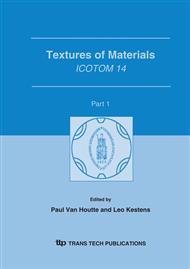p.681
p.687
p.693
p.699
p.705
p.711
p.719
p.725
p.731
The Role of Crystallographic Texture of Ti-6Al-4V Alloy on Cell Attachment and Proliferation
Abstract:
Owing to their lower modulus, great corrosion resistance and superior biocompatibility, titanium alloys are increasingly used as artificial joint replacements. However bone bonding capability of these materials needs to be improved. Many studies are currently conducted to improve the osseo-integration of titanium based implants. In the present study, the role of crystallographic texture of titanium alloy Ti-6Al-4V on bone bonding capability was investigated in vitro systems. X-ray diffraction analysis was used to determine preferred orientation in each substrate. These substrates were seeded with preosteoblast cells to examine cell attachment and proliferation. Attachment of cells was assessed by counting the number of adhered cells within 30-240 min. The proliferation rate of cells was measured between the 3rd-11th days of incubation. The results suggest that the substrate with (100) orientation shows better osteoblastic cell adhesion and proliferation rate than the (110).
Info:
Periodical:
Pages:
705-710
Citation:
Online since:
September 2005
Authors:
Keywords:
Price:
Сopyright:
© 2005 Trans Tech Publications Ltd. All Rights Reserved
Share:
Citation:


